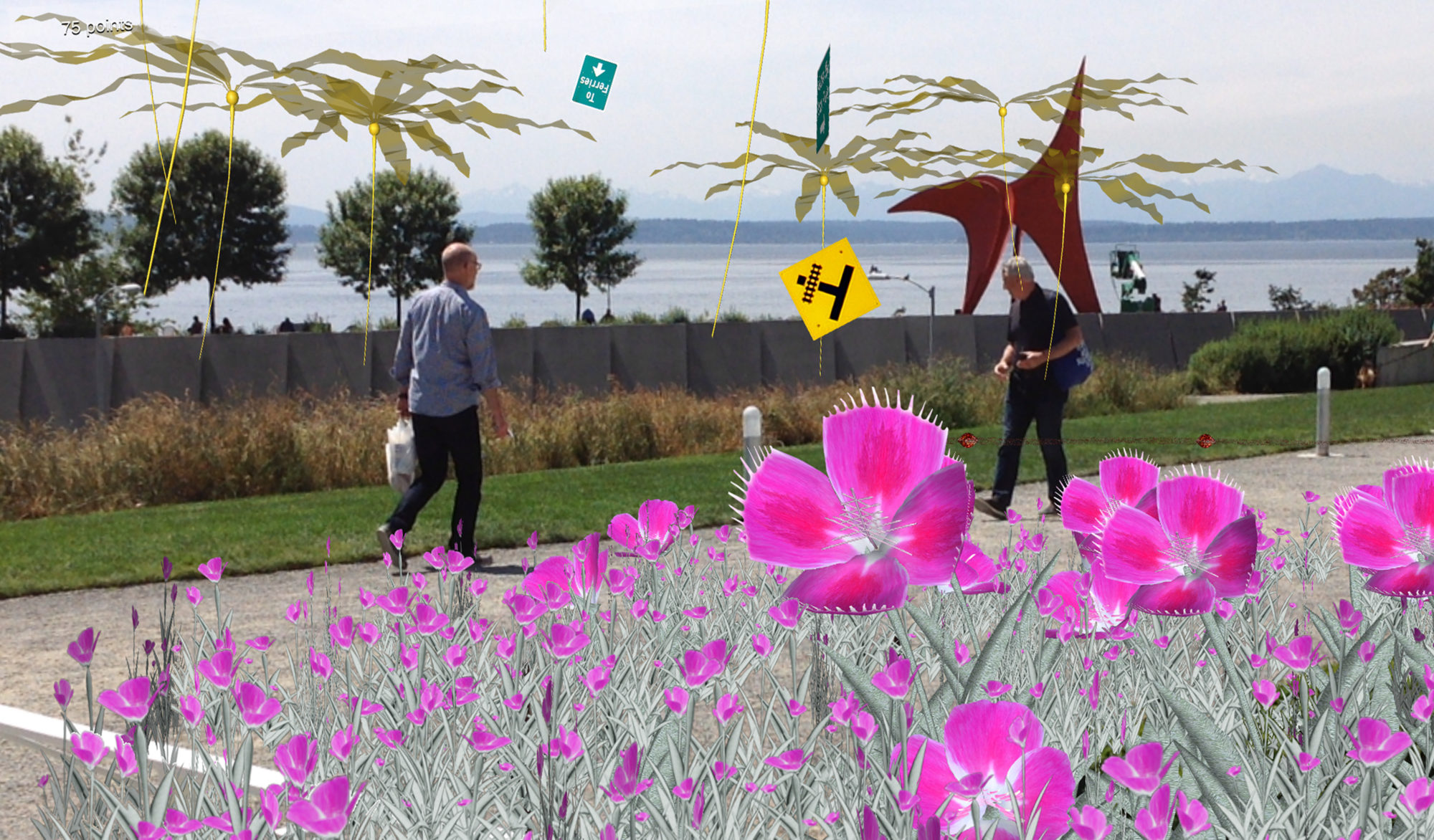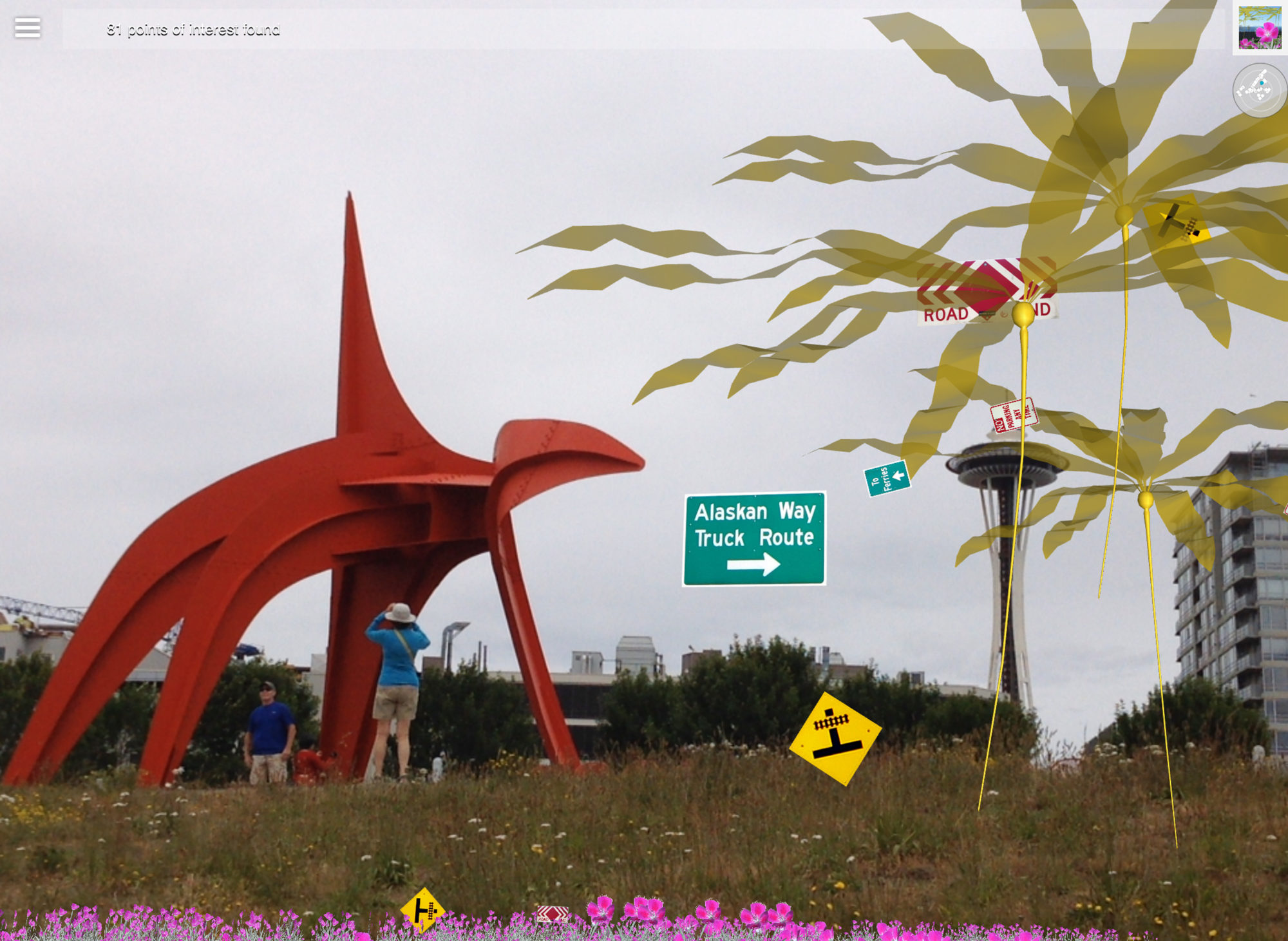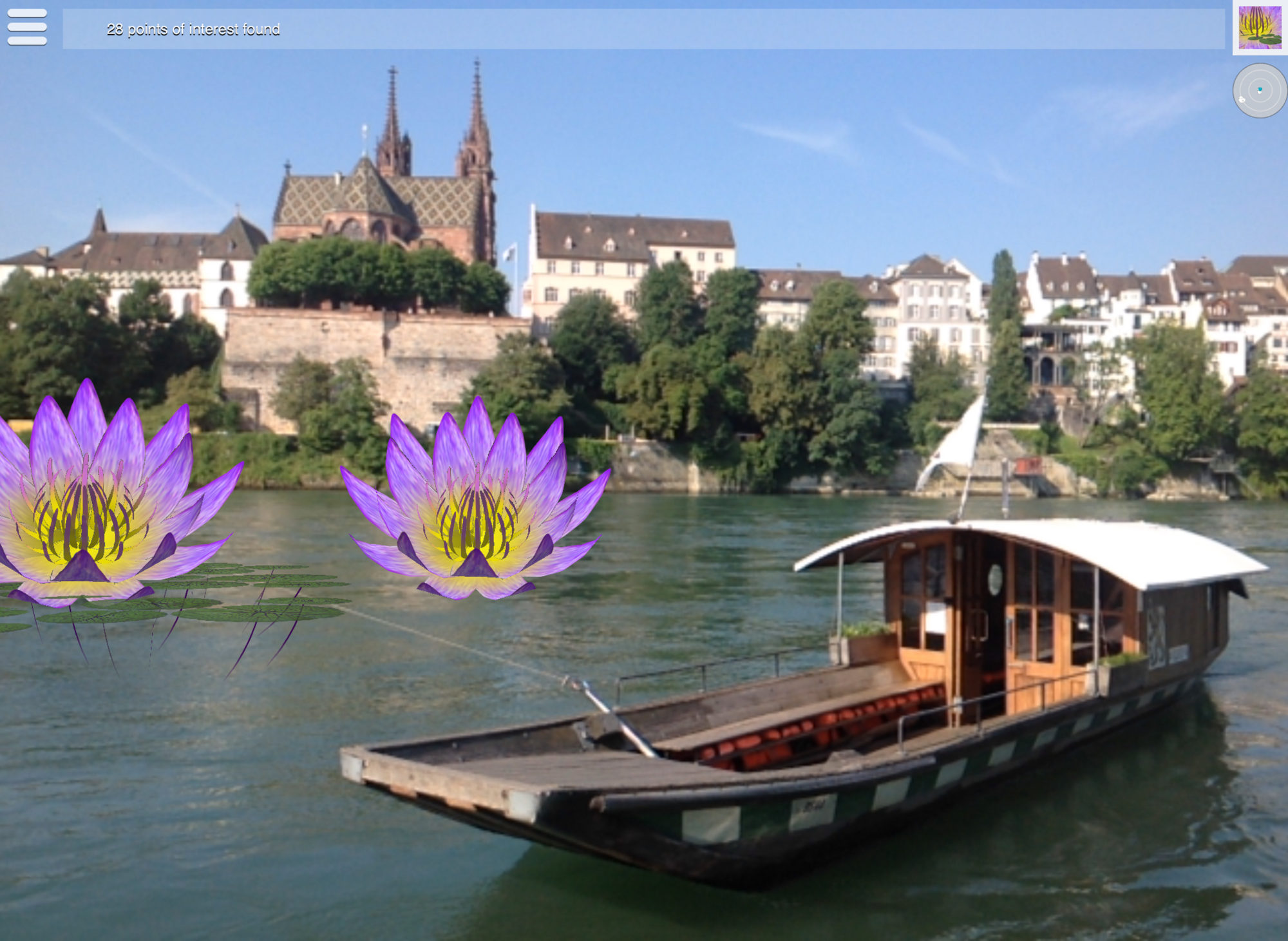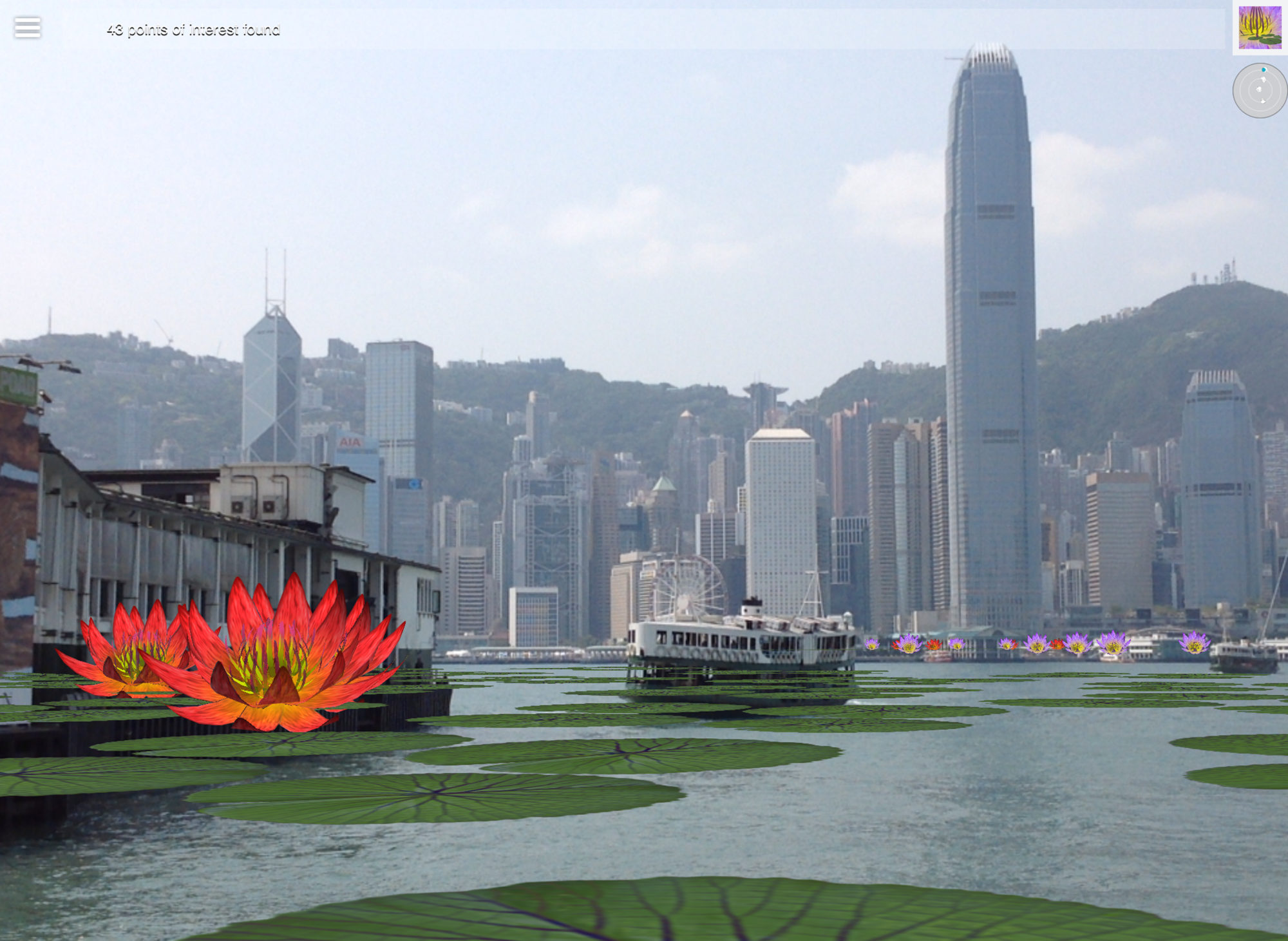Amitav Ghosh: The Great Derangement
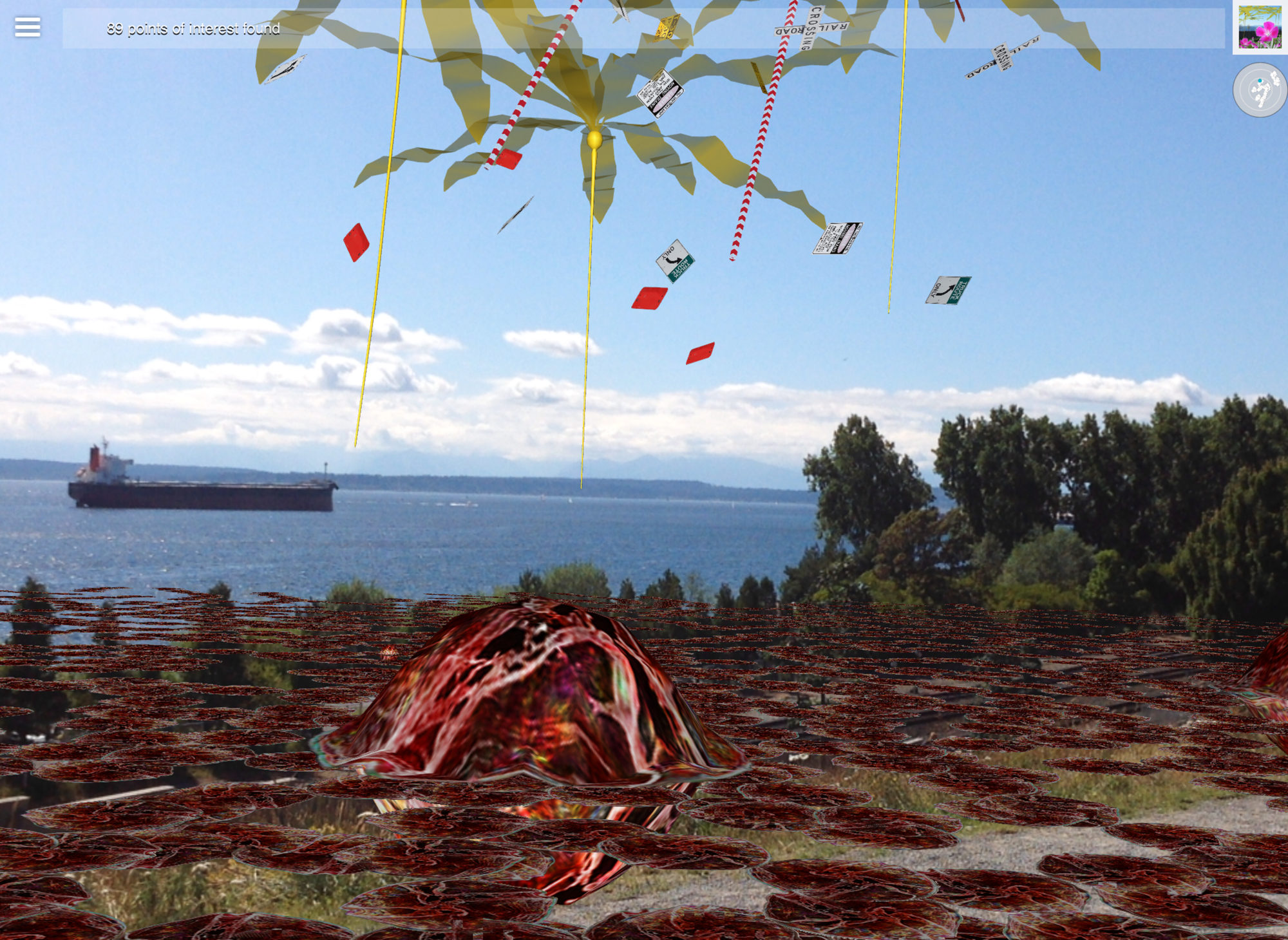
“Gardens of the Anthropocene,” augmented reality installation, Tamiko Thiel, 2016. Flying bullwhip kelp and giant red algae, Seattle Art Museum Olympic Sculpture Park.
Share:
Throughout the curatorial research that I have been doing since 2015 on the complex histories of oceans, Amitav Ghosh’s Ibis trilogy drew for me a rich picture of how 19th-century port cities in the Indian Ocean were connected to each other through the opium trade and its attendant indentured labor. Comprising Sea of Poppies (2008), River of Smoke (2011), and Flood of Fire (2015), the trilogy is full of characters who are all, in some way, connected to the Ibis, a trade ship. Their transnational lives unfold against the backdrop of cities like Calcutta, Bombay, Hong Kong, and Port Louis.
When I set out to curate the 2017 Lofoten International Art Festival (LIAF) with Milena Hoegsberg, inspired by outposts along the global oceanic trade routes, the idea was to look 50 to 100 years into the future and imagine Lofoten as a port city on a new trade route connecting Hamburg with Beijing. The Northern Passage is a much anticipated route that will be open once more polar ice has melted. We were curious about the likelihood of the Arctic becoming a global arena for trade, all the more since estimates state that large oil and gas reserves will become accessible beneath Arctic waters. During our research, we discovered that drilling oil in the Arctic is a very dangerous undertaking if we care about the livelihood of our whole planet. Nevertheless, the Norwegian government continues to give out new drilling licenses for sites north of the Arctic Circle. A more pressing question then came to the fore in the exhibition: why is a wealthy country like Norway behaving in such an irrational way and deciding against nature in favor of more oil?
In July 2017, just a few weeks before LIAF opened, The Great Derangement: Climate Change and the Unthinkable by Amitav Ghosh became available in Europe. In this nonfiction book Ghosh proclaims that we indeed live in times of derangement, of insanity and confusion. Ghosh explains why climate change is traditionally ignored, suggesting that one of the reasons is simply the limits of human imagination. This material constitutes the main narrative in the first part of the book, titled “Stories.” He takes his analysis further in sections titled “History” and “Politics.” The “History” section explains how fossil fuels have been linked to power and empire—though empire was not the first to exploit such resources. In the final part of the book, “Politics,” Ghosh explains why the empire and nation states are not equipped to deal with climate change because of their very nature and their vested interest in protecting the current status quo.
I had the pleasure of asking Amitav Ghosh some questions about his new book.
“Gardens of the Anthropocene,” augmented reality installation view, 2016 [image courtesy of Tamiko Thiel and Seattle Art Museum Olympic Sculpture Park]
Heidi Ballet: In your new book The Great Derangement you talk about climate change denial, the inability to make positive change and to introduce a sense of responsibility for degrading the environment. While many climate change discussions see capitalism as a force obstructing progress, you discuss how tightly capitalism is linked to colonialism. I kept thinking about the idea of “climate justice,” the idea that if citizens of India and China would be afforded the carbon footprint per capita that the West has had, our existence on the planet would be immediately threatened. How have we been able to deny this elephant in the room of justice so long?
Amitav Ghosh: Climate change is often framed as an economic problem, caused by consumption, production, distribution, and the emissions that these processes entail—“capitalism,” in other words. The dominance of this framework may be a consequence of the fact that economistic ways of thinking have come to pervade every sphere of contemporary life. But in my view these economistic framings of the issue frequently serve to mask other, equally important aspects of it, such as military competition, relationships of domination and subordination between and within countries, and indeed, the dynamics of empire, broadly conceived. This masking happens at multiple levels and in many different ways. Consider, for example, the idea of capitalism as the principal driver of climate change—a view articulated by Naomi Klein and many others. The trouble is that capitalism is not one thing: we know now that East Asian capitalism for instance, was labor- rather than resource-intensive and that it had a much smaller ecological footprint than the version of capitalism that was prevalent in Britain and the United States. Yet it was the Anglo-American version of capitalism that became dominant around the world—and this version cannot be understood without considering the history of imperialism and global conquest. As for “climate justice” it is increasingly clear that the powers-that-be in the world are determined to close the door on this issue: it was barely mentioned in the Paris Agreement.
One unsettling fact that Ghosh named in his book is the likelihood that empire might have halted the climate calamity, as the burning of fossil fuel has always been closely linked to distributed power. Ghosh mentions Timothy Mitchell’s comparison of power distribution in the coal industry with that in the oil industry. Mitchell points out that coal moves through a large distribution network with multiple choke points where organized labor can exert pressure on corporations and the state, whereas oil moves through pipelines and can bypass concentration of labor, which makes it an important instrument of disempowerment. According to Mitchell it is exactly for this reason that the American and British political elites encouraged the use of oil over coal after the First World War.
“Gardens of the Anthropocene,” augmented reality installation view of flying bullwhip kelp with Calder’s “Eagle,” 2016 [image courtesy of Tamiko Thiel and Seattle Art Museum Olympic Sculpture Park]
HB: You say that politics are not going to do the job due to the very nature of the nation state that protects its citizens but fails to think about global responsibility. You note that in the future people will look back at our time as the time of ‘great derangement’ and blame politics for this state of denial and inertia, but they could also blame art. Art these days is very occupied with identity politics and, instead of taking a practical approach towards climate change, it is tainted by the idea of individual morality, splitting the difference between the two issues. Do you feel artists are complicit or just not understanding the problem?
AG: In the course of the 20th century, all the arts became increasingly centered on the human mind and the human sensibility, and increasingly decoupled from the material world. If you think of all the major literary and art movements of the past century you’ll see that they all tended towards an increasing abstraction. Countervailing movements like “social realism,” etc., invariably came to be marginalized and discredited. There were some major political factors in this, of course, like the ideology of the Cold War, but the cumulative effect, in any case, is that we have lost a sense of connection with our surroundings. Human-centeredness in this sense seems to be largely an effect of “modernity.” In other words, the very processes that pump greenhouse gases into the atmosphere seem also to blind us to the consequences by making us ever more closely focused on the human.
Ghosh writes that the Cartesian division between humans and nonhumans has led humans to prioritize themselves above all else. This thesis is not unlike Donna Haraway’s thinking in her 2016 book Staying with the Trouble: Making Kin in the Chthulucene. Ghosh illustrates this human-centeredness in his book, stating that people know very well where they were when 9/11 happened, but most likely no one will remember where they were when the Larsen C ice shelf broke off.
“Water Lily Invasion,” augmented reality installation view, 2013 [image courtesy of Tamiko Thiel and Basel Rhine Ferry]
HB: Towards the end of the book there is a very interesting comparison between the style and wording of the Paris climate agreement and a document written by Pope Francis.
While the document of the pope is clear and straightforward, the analysis of the Paris agreement points to a lot of techno-optimism, corporate wording, and sentence constructions that make it very hard to understand, [and thus] predicting its outcome. There are several other moments of literary analysis throughout the book, at a point I felt it might be a very useful analysis of the narrative that we are living in, maybe something like modernist-linear-progress thinking. Did I understand this correctly?
AG: We are teetering on the edge of a new era in which many of our past habits of thought and practice have become blinders which prevent us from perceiving the realities of our present situation. Writers, artists, and thinkers everywhere are still struggling to find the concepts and ideas that will make it possible to engage with the unprecedented events of this new era. But to discover such modes of engagement takes time—and that is exactly what we don’t have.
Ghosh describes Western modernism as an ideology defined by a concept of time that necessitates a constant “being ahead” and a terror caused by a fear of being left behind or proved backward. The West is intellectually invested in promoting its modernity as singular. The goal for the non-Western writer or artist was then to try to “catch up” or at best “keep up” with Western modernity, instead of writing about her own, even as forces of modernity were active separately around the world. According to Ghosh, bank balance was the one thing that made a difference in the recognition of other modernities, and it was consequently thanks to the bank balance of Japan that the idea of Japanese modernity was accepted in and of itself.
“Water Lily Invasion,” augmented reality installation view, 2013 [image courtesy of Tamiko Thiel and Basel Rhine Ferry]
HB: There has been a lot of talk in the arts about the oceans as the last frontier to be colonized, with the ocean representing stories of failure and violence. These days our world is reflected in the ocean being a gray zone where dumping practices end up and … deep sea mining business [looms]. The ocean as “free enterprise at its freest” is probably an important backbone of the port cities that made the network of colonial trade, something that is beautifully described and illustrated in your Ibis trilogy. Do you have any thoughts about the future of the oceans and how they will be, and should be, managed? Do you mind telling something about the relation between port cities, the ocean, and colonialism, and whether you feel the character of port cities has changed over time [since] decolonization.
AG: Today the multiple crises of our world are becoming increasingly manifest in the oceans. There is, first of all, the issue of sea level rise, which will displace many millions and swamp several island nations. Then there is the catastrophic environmental crisis of “dead zones” and steeply declining fish stocks. One of the worst affected areas is the Bay of Bengal, which supports tens of millions of people. At the same time, oceans are being “securitized” in unprecedented ways—and this process will only accelerate in the future. One reason for [it] lies in new forms of production, which now rely on complex supply chains requiring global coordination (or “logistics”). These supply systems in turn need to be protected from disruption, so increasingly private companies are expanding into the domain of providing “supply route security.” Today, the whole pattern of international trade is anchored to “logistics cities,” the first of which was Dubai. But this model is being copied around the world, and it is creating forms of law and citizenship that are completely unprecedented. For instance, workers in certain logistically important ports may require security credentials from the US—even though they are citizens of other countries, and live on other continents. Needless to add, within these areas, workers have very few rights, because of so-called security concerns. These logistics hubs actually function like military outposts, with massive security around them. Some of them are even built in former prisons and military camps—such as the former Camp Bucca in Iraq, which has now become Basra Logistics City.
“Gardens of the Anthropocene,” augmented reality installation view of flying bullwhip kelp and giant red algae, 2016 [image courtesy of Tamiko Thiel and Seattle Art Museum Olympic Sculpture Park]
HB: I just worked as a curator on a project in Norway, on the Lofoten islands. Lofoten is one of the only places on the Norwegian coast where oil drilling is not allowed, since [doing so] would influence the ecology of one of the richest fisheries in the world. Regardless of that fact, [Norway’s] current right-wing government is pushing to open the area for exploitation. We made an archive where facts about these type of decisions in Norway are mixed with science fiction books [that have] dystopian (and sometimes utopian) outcomes to give a hint of what might come if we follow the muscle movement, this kind of right-wing extractivist reflex of the Norwegian government. The underlying thesis of the exhibition was similar to the global one that you discuss, namely that the most vulnerable groups will suffer the most in ‘armed life boat’ politics. In Norway it is the Sami minority in the North that suffers the most from the consequences of the Norwegian policies unfortunately. Do you think sci-fi can mean something for us today?
AG: It is interesting that you mention Norway, because one of the most important books on climate change is Kari Marie Norgaard’s Living in Denial: Climate Change, Emotions, and Everyday Life, an ethnographic study of a small Norwegian town. The inhabitants of this town (which is called “Bygdaby” in the book) are wealthy, well-educated and politically conscious, with progressive views on issues such as migration and race. They are also extremely well-informed about climate change, which has impacted them directly in that it has affected [some] of their main sources of revenue—skiing and tourism. There is now less snow, hence fewer tourists. Yet in this town climate change is never discussed publicly and very rarely spoken of privately; nor are the people of the town, who are active on many political issues, at all interested in taking up this cause. What the book shows is that we cannot attribute inaction on climate change to ignorance (or “denial”), or to a lack of education, or to political apathy. The most terrible thing about our present predicament, as the writer Roy Scranton says, is that everybody already knows. The problem lies somewhere else—perhaps, as you say, in our modes of imagining and thinking.
In Economy and the Future: A Crisis of Faith (2014), French philosopher Jean-Pierre Dupuy writes: “If we destroy nature is it because we hate nature? Of course not—we merely hate one another.”
He may well be right.
The images accompanying this interview are from Tamiko Thiel, a Munich-based visual artist who utilizes augmented and virtual reality, multi-media installations, and performances to examine space, imagination, and memory. Her VR and AR installations have sought to represent the future effects of climate change, reproduce the Berlin Wall prior to its collapse, and enable viewers to experience rare visual disorders. Her body of work might be described as a set of tools designed to help people empathize, or imagine the unimaginable. Thiel and mystery hacker /p’s latest augmented reality piece, Unexpected Growth, is featured in the group show Programmed: Rules, Codes, and Choreographies in Art, 1965–2018 at the Whitney Museum of American Art. Unexpected Growth, which take over the entire 6th floor terrace of the Whitney, employs augmented reality to depict the degradation of coral reefs, compelling viewers to confront that which is typically invisible.
